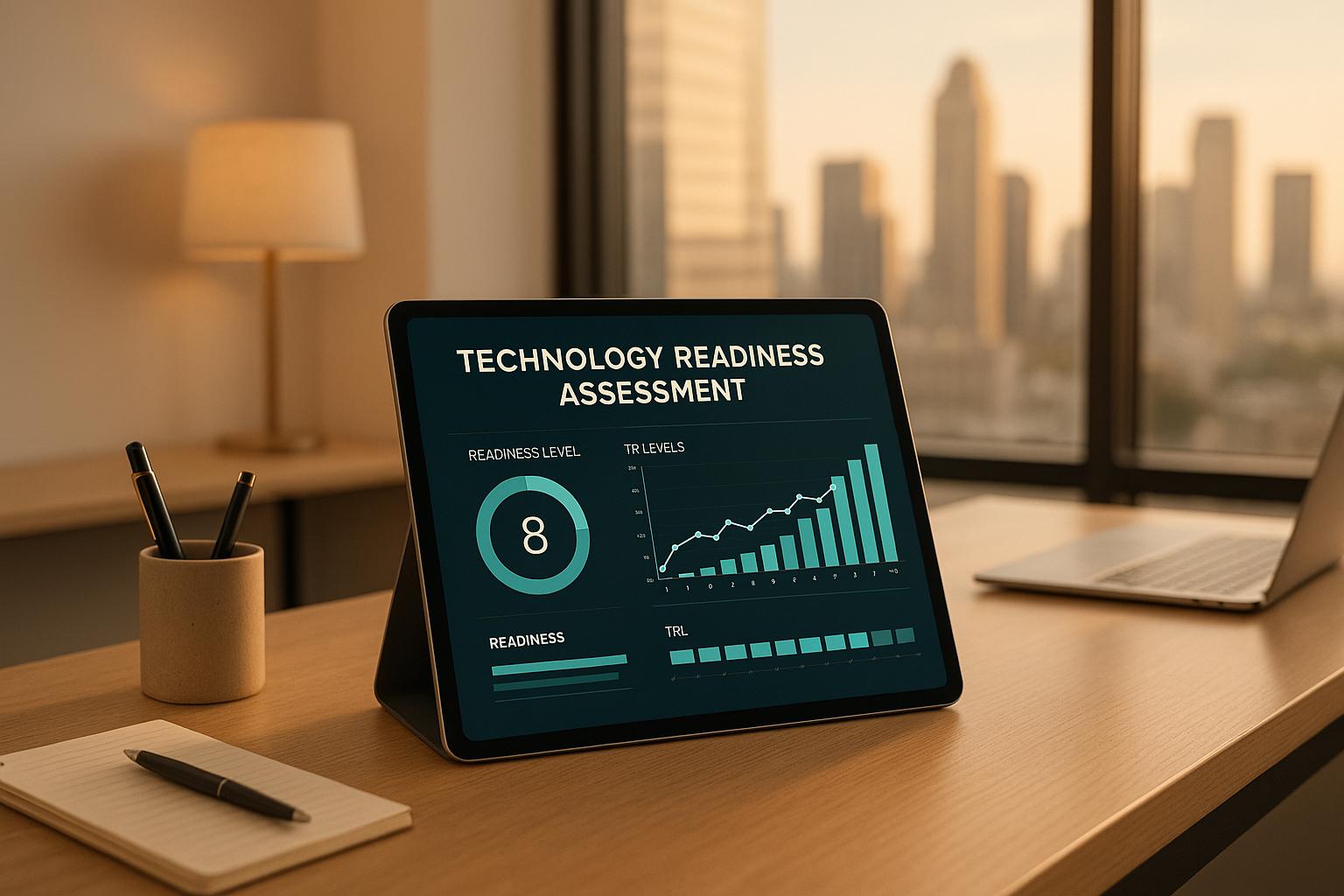Real-time risk monitoring tools are essential for identifying and responding to threats as they happen. These tools provide instant insights, automated risk scoring, and AI-driven analytics to help businesses stay ahead of challenges like market shifts, cybersecurity risks, and compliance issues. Here’s a quick look at seven standout tools:
- Jit: AI-powered platform for DevSecOps, automating vulnerability management and compliance reporting.
- Lark: AI-driven analytics for spotting unusual patterns and predicting trends.
- SmartSuite: Combines risk monitoring with work management, offering customizable dashboards and alerts.
- LogicGate: Centralized GRC (Governance, Risk, Compliance) solution with automated scoring and enterprise-wide visibility.
- New Relic: Full-stack monitoring tool with anomaly detection and seamless integration across IT systems.
- Scrut Automation: Simplifies compliance management with real-time insights and automated reporting.
- MetricStream: Enterprise-grade risk management platform utilizing AI for anomaly detection and third-party monitoring.
Key Features to Look For:
- Real-time data visibility: Instant access to live risk indicators.
- Automated scoring: AI-driven risk prioritization.
- AI analytics: Predictive insights and anomaly detection.
- Integration: Compatibility with existing systems like ERP or cloud platforms.
- Customizable alerts: Tailored notifications to the right teams.
- Compliance support: Audit-ready documentation and regulatory tracking.
Quick Comparison
| Tool | Key Features | Pricing Model | Best For |
|---|---|---|---|
| Jit | AI for DevSecOps, vulnerability triage | Starts at $29/month | Software development teams |
| Lark | AI analytics, trend prediction | Freemium, Pro from $12/user | Cross-functional teams |
| SmartSuite | Risk scoring, workflow integration | Starts at $10/user | Small to mid-size businesses |
| LogicGate | GRC, compliance tracking | Custom pricing | Enterprise compliance |
| New Relic | Full-stack monitoring, anomaly detection | Starts at $99/month | IT operations |
| Scrut | Compliance automation, evidence tracking | From $3,000/month | Mid-sized companies |
| MetricStream | AI-driven enterprise risk management | Enterprise pricing | Large organizations |
Choosing the right tool depends on your business needs, budget, and compliance demands. Whether you’re a small business or a large enterprise, these tools provide tailored solutions to improve risk management and decision-making.
Real-Time, Data-Driven Risk Management
How to Choose Real-Time Risk Monitoring Tools
Picking the right real-time risk monitoring tool means focusing on features that ensure swift threat detection and response. Here’s what to look for:
Real-time data visibility is non-negotiable. The tool must provide instant access to risk indicators across all areas of your business, without delays or data lags. It should integrate seamlessly with your existing systems to deliver consolidated, up-to-the-minute risk insights.
Automated risk scoring is a game-changer. The best tools use advanced algorithms to assign risk scores automatically, based on set criteria and historical data. This reduces manual work, ensures consistency, and speeds up evaluations.
AI-driven analytics are now a must-have for modern risk management. Tools with machine learning capabilities can uncover patterns that might go unnoticed, predict potential risks, and improve accuracy over time. These systems adapt to your organization’s specific risk profile, cutting down on false alarms.
Scalability with enterprise systems is critical for growing businesses. The tool should handle increasing data volumes without slowing down and integrate easily with systems like ERP, CRM, and other core business platforms. Whether you prefer cloud-based, on-premises, or hybrid setups, the tool should offer deployment flexibility to match your needs.
Customizable alerting and reporting features make sure the right people get the right information at the right time. Look for tools that let you tailor alert thresholds, choose notification methods, and create reports in formats ranging from high-level executive dashboards to detailed technical breakdowns.
User interface design plays a big role in how effectively the tool is used. A well-designed interface makes it easy to interpret complex risk data and act quickly. Features like role-based access controls are also important, ensuring users see only the information relevant to their responsibilities.
Compliance and audit capabilities are essential, especially in regulated industries. The tool should support audit tracking, regulatory reporting, and compliance documentation to help you meet industry standards without extra hassle.
Finally, don’t overlook budget considerations. Beyond the upfront cost, think about licensing, implementation, training, and maintenance. Factor in the total cost of ownership, including what it might cost to scale the tool as your organization grows.
1. Jit
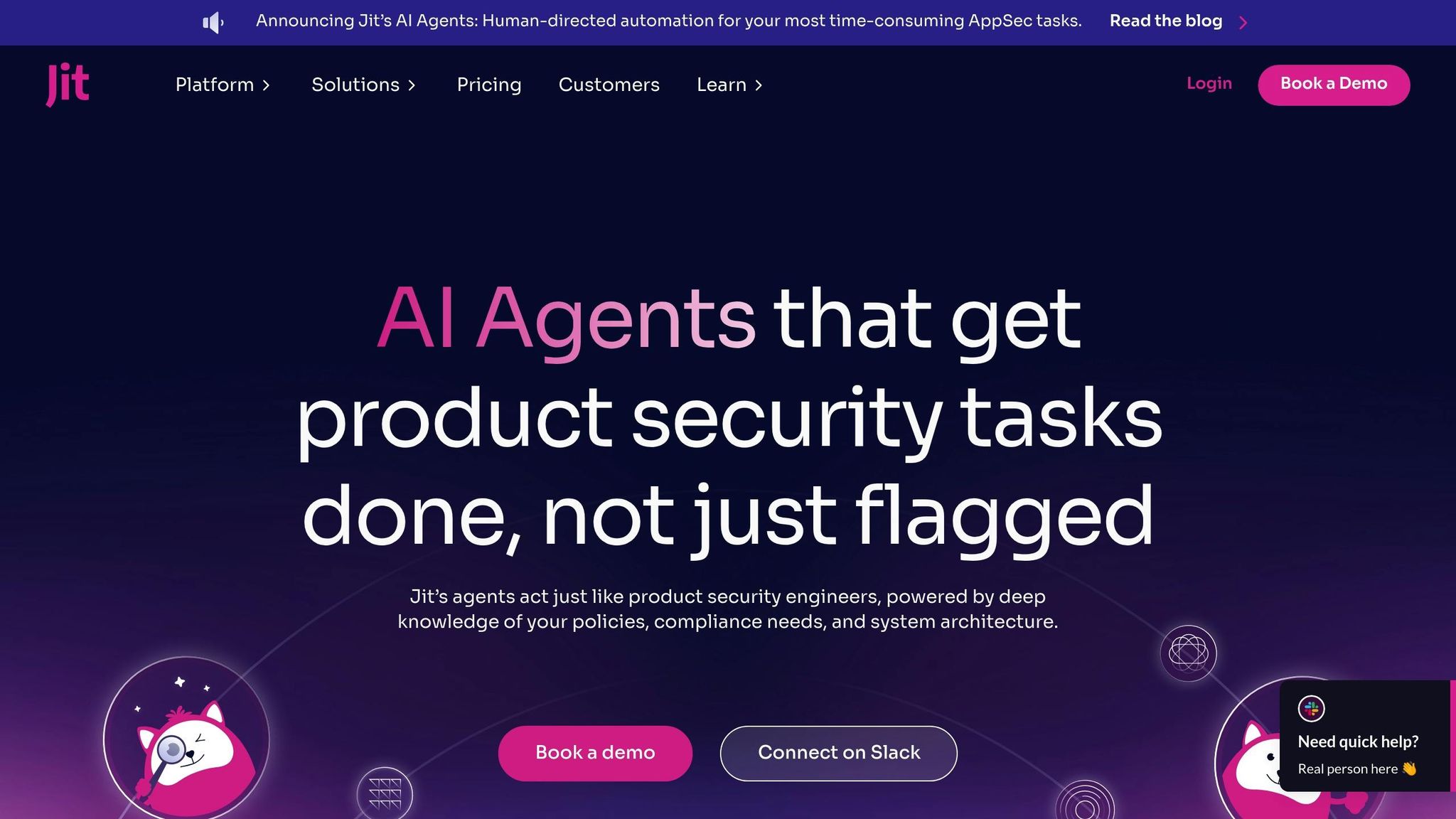
Jit is a developer-focused security platform that uses AI-powered automation to simplify enterprise risk monitoring. It eliminates the need for manual vulnerability assessments and risk prioritization by relying on intelligent AI Agents.
Automated Risk Scoring and Reporting
Jit’s AI-driven scoring system evaluates alerts and prioritizes risks by factoring in exploitability, business impact, and security guidelines specific to your organization. These assessments are powered by contextual intelligence, allowing the platform’s AI Agents to automatically investigate and rank security alerts based on these critical criteria.
A key feature of Jit’s approach is its proprietary Company Knowledge Graph, which pulls data from various sources, including security policies, compliance frameworks (like SOC 2 and PCI-DSS), existing tools, system architecture, and runtime environments. This ensures that risk scores are tailored to your business context instead of relying on generic threat assessments.
The platform provides full transparency in how it prioritizes risks. Users can see exactly how priorities are calculated and adjust the factors influencing scoring to align with their organization’s unique needs.
"The Context Engine is amazing. What I enjoy most is that I can modify the factors that go into the priority and easily see how a priority was calculated." - Chris, DevOps Manager
For compliance, Jit simplifies reporting by automatically generating audit-ready documentation. It continuously maps your systems against compliance frameworks and collects the necessary proof points. These reports integrate easily with existing GRC platforms, while the system automates compliance gap analyses and related documentation.
This advanced scoring system forms the foundation for Jit’s AI-powered threat detection capabilities.
AI-Powered Analytics and Anomaly Detection
Jit’s system is designed to highlight critical issues that demand immediate action, cutting through the noise that often overwhelms security teams.
"With Jit's AI Agents we are able to delegate a lot of the tedious work of performing constant risk assessment, and it's shockingly good at surfacing what needs to be dealt with." - Dudu Yosef, Director of Security at LinearB
The platform also excels at vulnerability triage. Its AI Agents automatically investigate alerts to identify genuine risks, reducing false positives and helping teams focus on the most pressing threats.
Scalability and Integration with Enterprise Systems
Jit is built to scale with enterprise needs. Its cloud-native architecture integrates seamlessly with popular development and security tools such as VS Code, GitHub, GitLab, Bitbucket, CI/CD systems, Cyera, Wiz, Orca, and Checkmarx. This allows organizations to centralize risk findings and unify application security testing tools - like SAST, DAST, and SCA - into one platform.
This integration creates a centralized vulnerability backlog that consolidates findings from multiple scanners. Jit’s AI Agents continuously analyze and correlate data across all connected systems, ensuring they can handle complex, large-scale environments.
"Product security tools should offer developer-centric automation, contextual risk prioritization, tool correlation and seamless integrations, and effective scalability to match a growing organization." - Jit Team
2. Lark
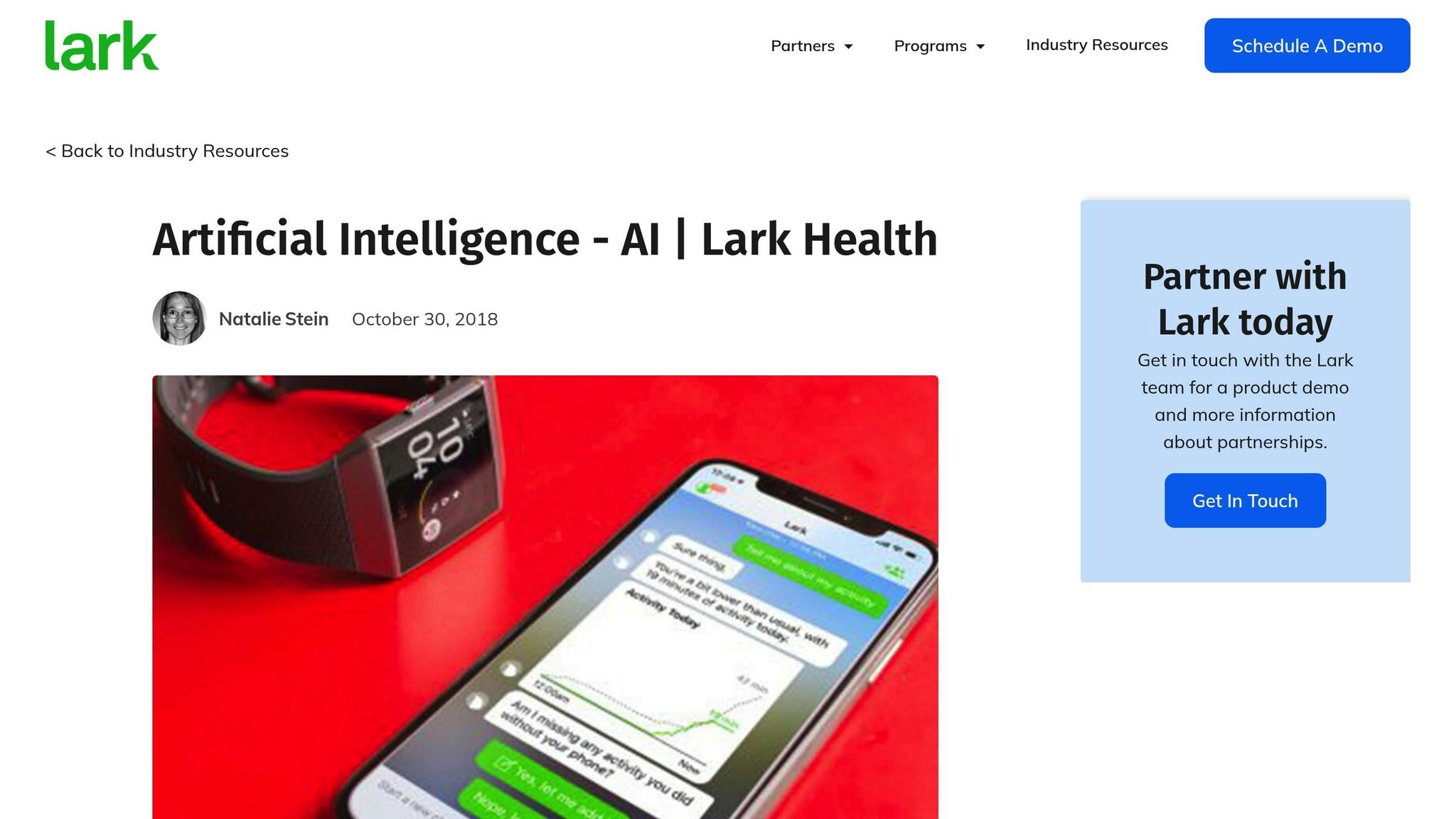
Lark uses advanced AI analytics to identify unusual data patterns, helping users stay ahead of potential issues like fraud, equipment malfunctions, or sudden market changes. Its machine learning models also provide insights into upcoming trends and predict customer behavior, giving businesses a clearer picture of what lies ahead.
3. SmartSuite
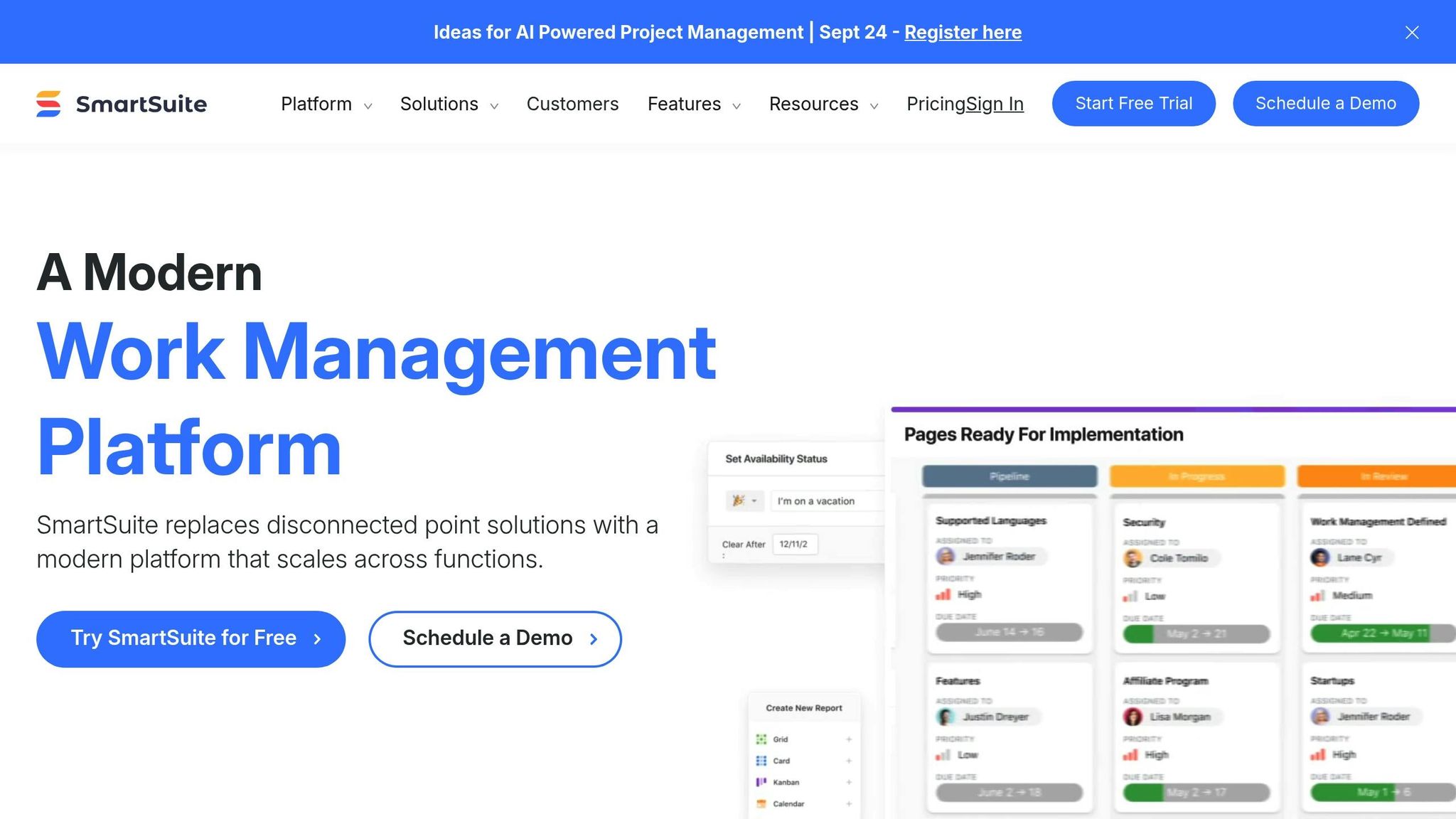
SmartSuite takes the baton from Lark's AI-powered insights and brings a fresh approach to risk management by integrating it directly with work management. This platform allows organizations to keep a close eye on risks in real time, helping them address potential issues across their operations effectively.
Real-Time Data Integration and Visibility
SmartSuite offers a centralized dashboard that pulls together data from various sources, meeting a key need for streamlined risk monitoring. With customizable views, stakeholders can focus on the most pressing risk indicators, making it easier to act quickly when challenges emerge.
Automated Risk Scoring and Reporting
One standout feature of SmartSuite is its ability to automate risk scoring and reporting. The platform provides specialized dashboards and alerts, constantly assessing risk levels and generating reports that shed light on new challenges. This eliminates the need for time-consuming manual data gathering, allowing teams to concentrate on solutions.
Scalability and Enterprise Integration
Built on a cloud-based framework, SmartSuite adapts seamlessly to the needs of growing organizations. It also integrates advanced security protocols and automates workflows, ensuring quicker responses to risks while maintaining operational efficiency.
4. LogicGate
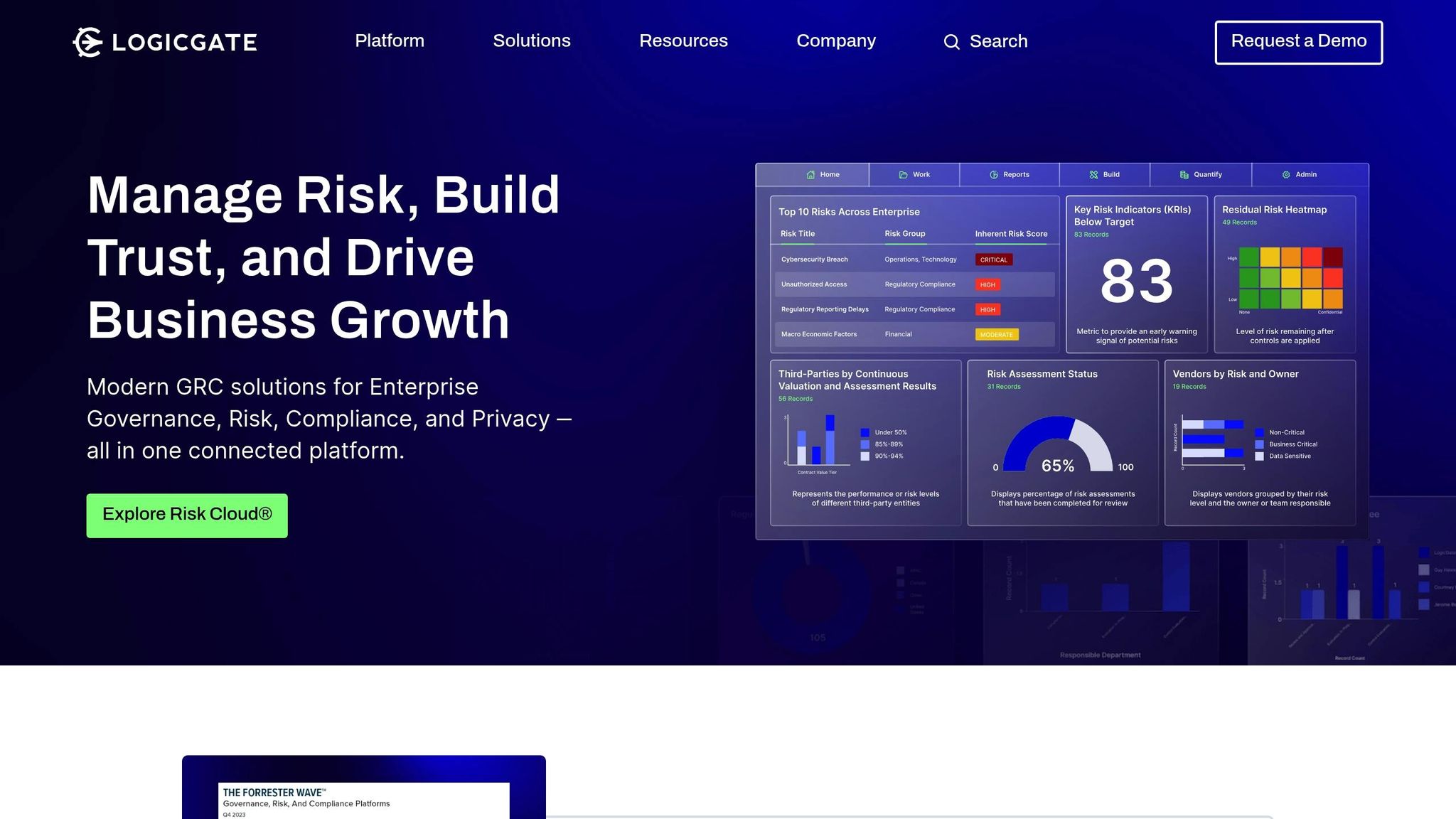
LogicGate Risk Cloud provides a centralized platform to manage Governance, Risk, and Compliance (GRC) initiatives. By integrating data from various systems, it creates a single source of truth that enhances visibility across business units. This unified approach simplifies risk management and improves decision-making at all levels.
Real-Time Data Integration and Visibility
One of LogicGate’s standout features is its ability to eliminate data silos, a common obstacle in enterprise risk management. The platform supports both pre-built and custom integrations, making it easy to gather and share critical risk data. Additionally, role-based dashboards allow users to monitor key metrics at a glance, ensuring that essential information is always accessible.
Automated Risk Scoring and Reporting
LogicGate takes risk management a step further by automating risk scoring, offering immediate insights that are both actionable and clear. The platform compiles data into visual formats like tables, charts, and heatmaps, making complex information easier to digest. For executives, it provides tailored reports and AI-generated summaries, helping them quickly grasp essential details. It even translates cybersecurity risks into financial terms, bridging the gap between technical teams and business leaders.
AI-Powered Analytics and Anomaly Detection
With its advanced analytics, LogicGate connects risk, control, and assessment data, enabling users to dive into specific metrics. AI-generated summaries further simplify complex scenarios, giving executives a clear understanding of potential risks and their implications.
sbb-itb-97f6a47
5. New Relic
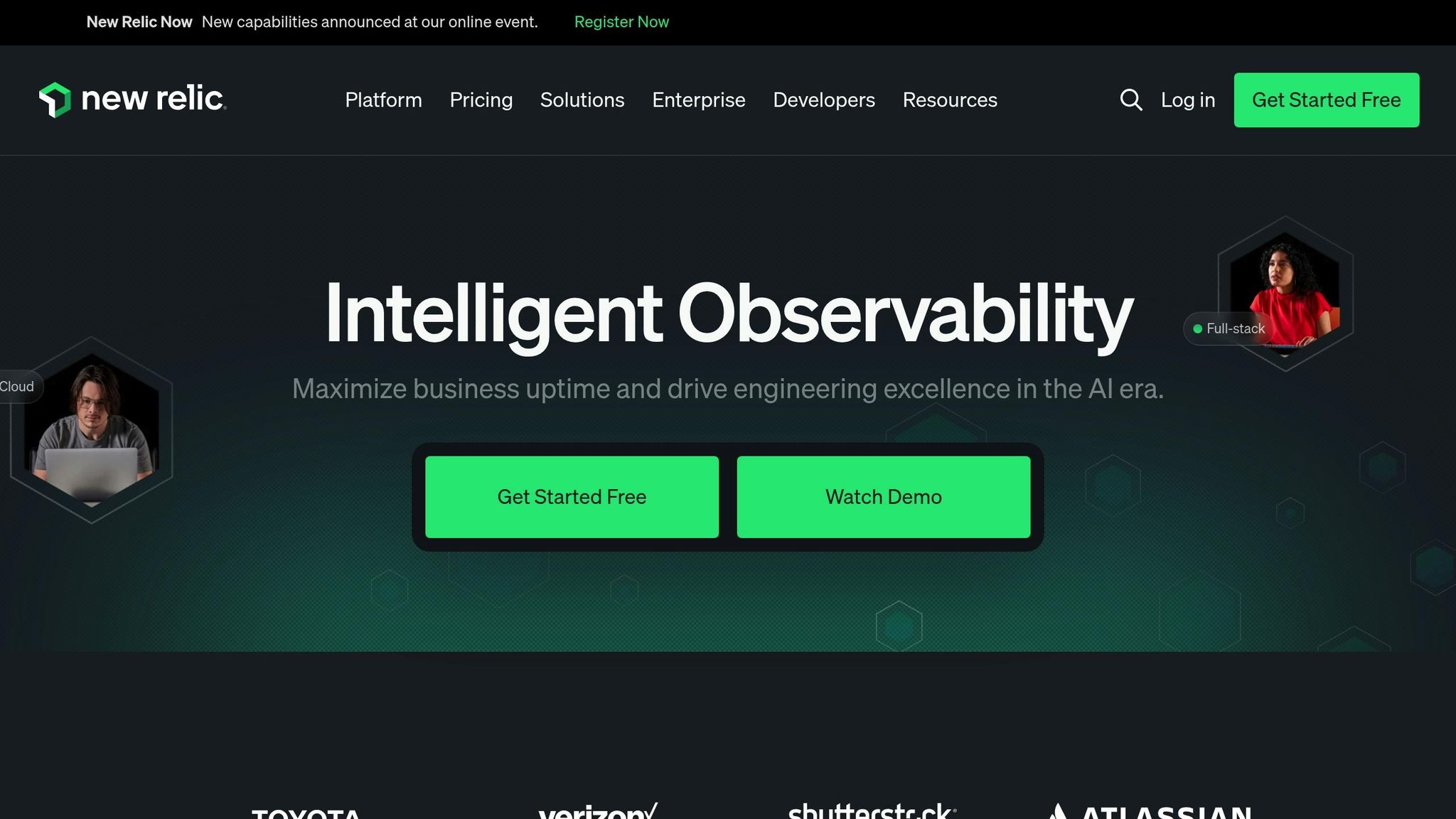
New Relic provides a robust platform for monitoring and managing risks across your entire technology stack. By offering full-stack visibility, it enables organizations to keep a close eye on applications, infrastructure, and digital customer experiences, making it an essential tool for real-time risk management.
Real-Time Data Integration and Visibility
One of New Relic's standout features is its ability to gather and correlate data from every corner of your technology ecosystem. It automatically maps dependencies between applications, services, and infrastructure, creating a unified view of your digital operations. This interconnected visibility helps teams pinpoint potential risk areas before they grow into critical problems.
With distributed tracing, New Relic tracks transactions as they move through various services, highlighting bottlenecks or failures that could disrupt operations. Customizable dashboards further enhance this functionality by presenting key performance indicators (KPIs) and risk metrics in a clear, accessible format for all stakeholders. This level of insight makes proactive risk detection not just possible, but practical.
AI-Powered Analytics and Anomaly Detection
New Relic's Applied Intelligence takes risk management to the next level with machine learning. The platform learns normal behavior patterns within your systems and flags anomalies that could signal emerging issues. This predictive capability allows teams to address risks before they affect business operations.
When incidents do occur, the platform’s AI minimizes noise by grouping related alerts and providing detailed context about the root cause. By analyzing millions of data points and uncovering patterns that might escape human detection, New Relic enables faster issue resolution, reducing downtime and its associated costs.
Scalability and Seamless Integration
Designed for large-scale enterprises, New Relic can handle vast amounts of data without compromising performance. With 400+ integrations and an API ecosystem, it connects seamlessly to popular DevOps tools, cloud platforms, and enterprise systems, ensuring smooth workflows across your organization.
New Relic also supports hybrid and multi-cloud environments, maintaining consistent monitoring and visibility no matter where your applications and services are hosted. This adaptability ensures that as your technology infrastructure grows and evolves, your risk management capabilities keep pace.
6. Scrut Automation
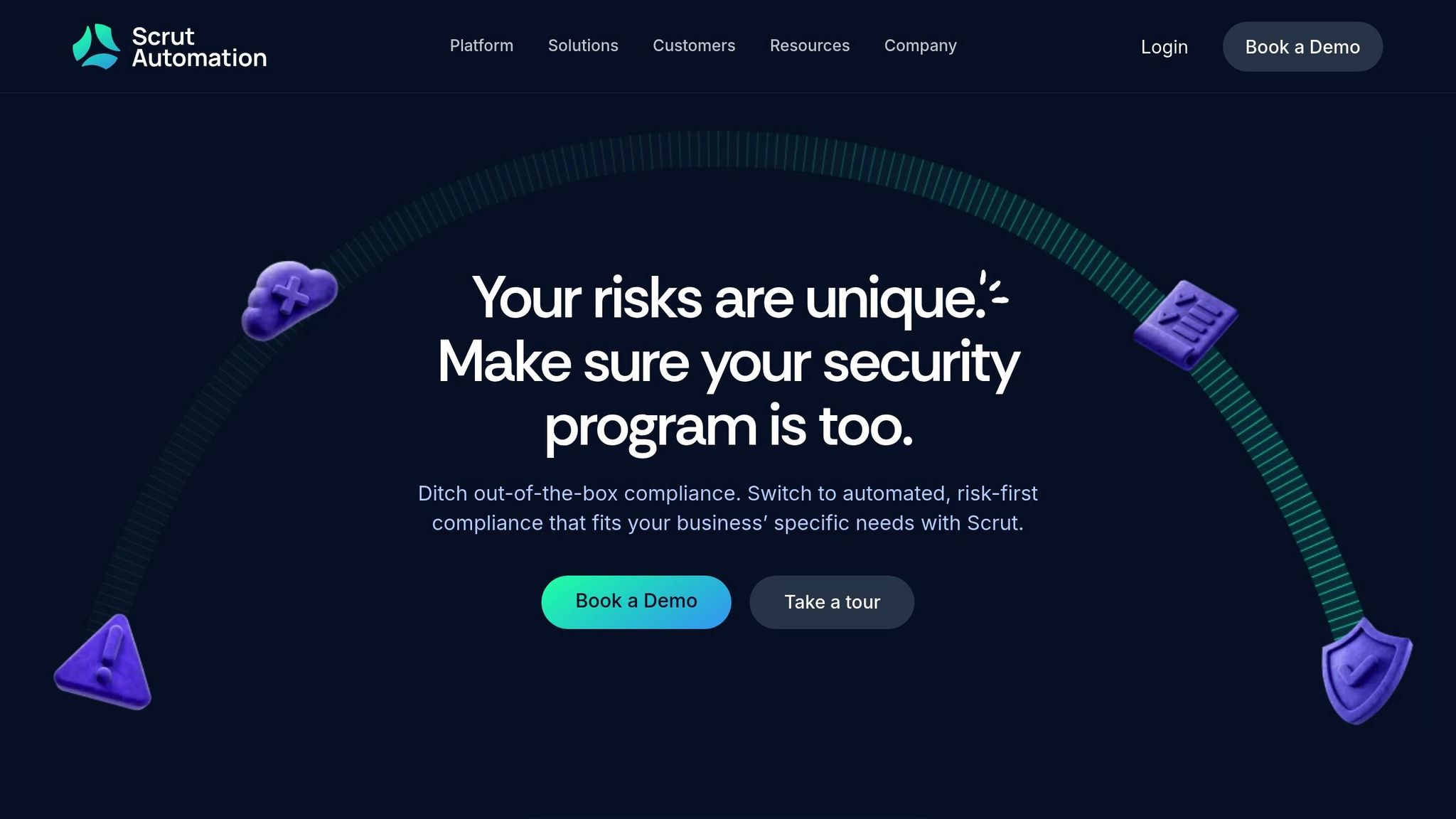
Scrut Automation delivers a GRC platform designed to simplify compliance management and provide real-time insights into an organization's risk posture across multiple frameworks and standards.
Real-Time Data Integration and Insights
Scrut Automation connects seamlessly with your existing tech stack to collect evidence and continuously monitor controls across cloud platforms and essential business applications. Its centralized dashboard offers a real-time view of compliance status, risk indicators, and control performance, all in one place.
The platform pulls data from various sources, including major cloud providers like AWS, Azure, and Google Cloud Platform, as well as widely used SaaS applications such as Salesforce and Microsoft 365. This ensures that risk assessments are always up-to-date, reflecting the current state of your infrastructure. Teams can quickly identify compliance gaps and receive instant alerts when critical controls deviate from their expected baselines. These integrations also fuel the platform’s automated risk scoring functionality.
Automated Risk Scoring and Reporting
Scrut Automation’s risk scoring engine uses real-time data and predefined criteria to calculate risk levels, helping teams focus on the most pressing issues.
Its automated reporting tools generate audit-ready compliance reports for frameworks like SOC 2, ISO 27001, PCI DSS, and HIPAA, eliminating the need for manual intervention. These reports include critical details such as evidence collection timestamps, control testing results, and risk trend analysis, making the reporting process faster and more efficient.
Seamless Scalability and Enterprise Integration
The platform supports enterprise growth with multi-tenant capabilities, allowing organizations to monitor compliance across multiple units from a single interface.
Scrut Automation also integrates with popular workflow tools like Jira, ServiceNow, and Slack. When the system detects compliance gaps or increased risk levels, it can automatically create tickets in project management systems and send alerts to the appropriate team members. This ensures risk management is seamlessly woven into your existing processes.
For added flexibility, the platform provides API access for custom integrations and supports single sign-on (SSO) for easy and secure access. Role-based permissions further enhance security by restricting sensitive data access to authorized users, while still enabling the necessary visibility for effective risk management.
7. MetricStream
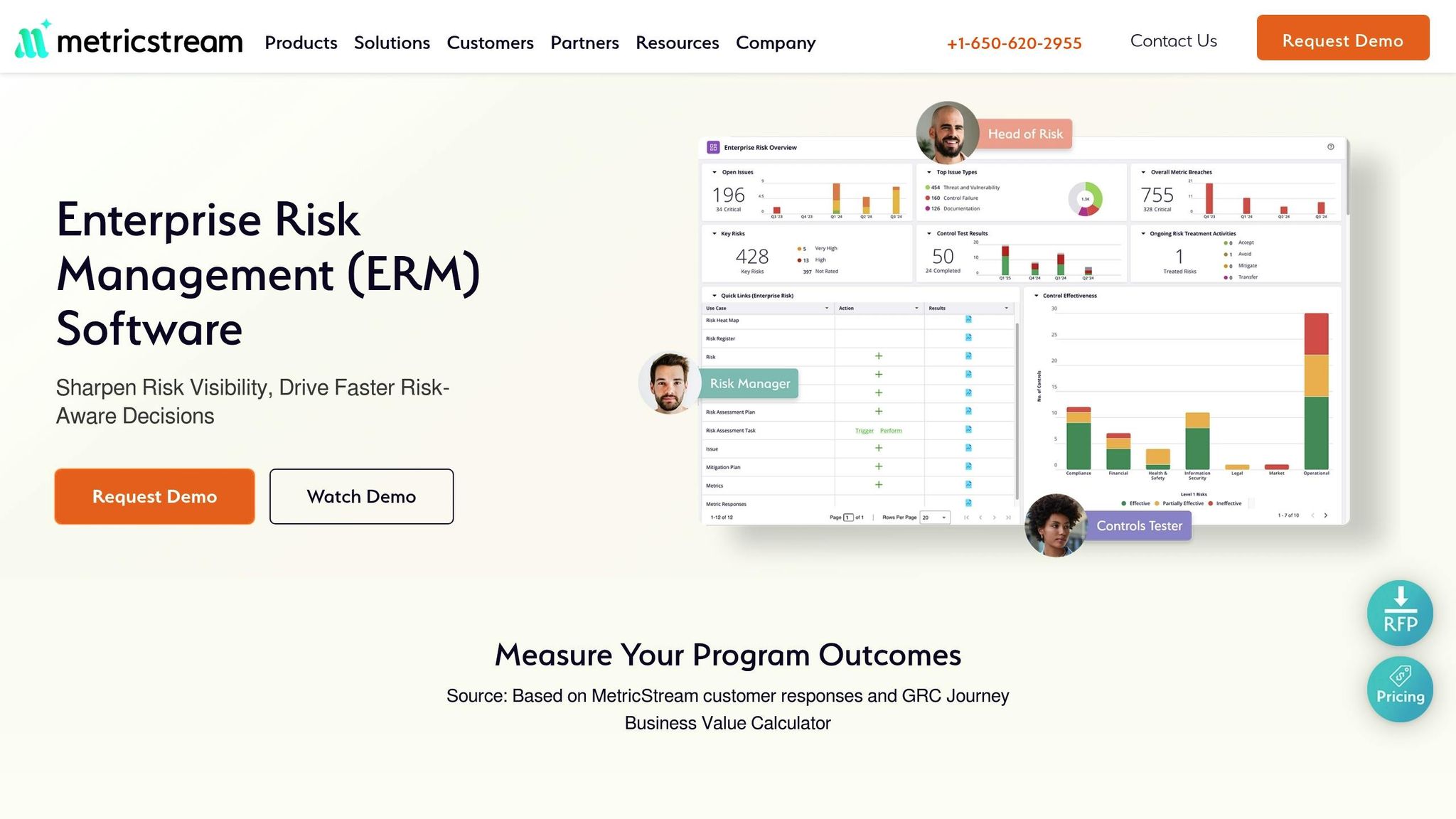
MetricStream takes risk management to the next level with its AI-driven solutions, focusing on real-time monitoring and advanced analytics. At the heart of its offerings is the MetricStream Intelligence engine, a powerful tool designed to keep a constant watch on risk factors and provide swift responses to potential threats.
AI-Powered Analytics and Anomaly Detection
The MetricStream Intelligence engine excels at processing massive amounts of both structured and unstructured data with impressive speed and precision. It identifies patterns, detects anomalies, and uncovers correlations that might go unnoticed by traditional human analysis. This anomaly detection system works tirelessly across various domains - whether it's scanning financial transactions, monitoring cybersecurity incidents, or analyzing third-party vendor behavior. Any unusual activity is flagged immediately for further investigation.
Tool Comparison Chart
When it comes to real-time risk monitoring, selecting the right tool can make all the difference. The best choice depends on your specific needs, budget, and how well each platform aligns with your goals. Below is a detailed comparison of seven tools, highlighting their key features, pricing models, and primary use cases.
| Tool | Key Features | Pricing Model | Primary Use Cases |
|---|---|---|---|
| Jit | DevSecOps automation, security scanning, vulnerability management | Usage-based pricing starting at $29/month per developer | Software development teams, CI/CD pipeline security |
| Lark | Real-time collaboration, integrated risk dashboards, workflow automation | Freemium model, Pro plans from $12/user/month | Cross-functional teams, project risk management |
| SmartSuite | Customizable workflows, risk scoring, automated alerts | Starts at $10/user/month; enterprise pricing available | Small to mid-size businesses, process management |
| LogicGate | No-code risk framework, compliance tracking, audit trails | Custom pricing, typically $15,000–$50,000 annually | Enterprise compliance, regulatory risk management |
| New Relic | Application performance monitoring, infrastructure alerts, anomaly detection | Consumption-based, starts at $99/month | IT operations, application performance, system reliability |
| Scrut Automation | Compliance automation, continuous monitoring, evidence collection | Starts at $3,000/month for mid-market | SOC 2, ISO 27001, GDPR compliance |
| MetricStream | AI-powered analytics, enterprise risk management, third-party monitoring | Enterprise pricing, typically $100,000+ annually | Large enterprises, comprehensive risk programs |
The risk monitoring market is evolving rapidly, with a valuation of $4.5 billion in 2024 and projections reaching $12.2 billion by 2033, growing at an annual rate of 12%. This growth is driving competitive pricing and innovation across different market segments.
For small and medium-sized businesses, cloud-based tools like Lark and SmartSuite offer subscription models that lower upfront costs, making them accessible entry points [10–14]. On the other hand, large enterprises often lean toward more advanced platforms such as MetricStream and LogicGate, which cater to complex regulatory requirements and multi-jurisdictional compliance needs [10,12].
To further clarify how these tools align with different organizational functions, here’s a breakdown:
| Department/Function | Recommended Tools | Key Benefits |
|---|---|---|
| IT Operations | New Relic, Jit | Real-time system monitoring, automated incident response, performance optimization |
| Finance & Accounting | MetricStream, LogicGate | Financial risk assessment, regulatory compliance, audit trail management |
| Compliance & Legal | Scrut Automation, LogicGate, MetricStream | Automated compliance reporting, evidence collection, regulatory framework support |
| Project Management | Lark, SmartSuite | Cross-team collaboration, project risk tracking, workflow automation |
| Software Development | Jit, New Relic | Code security scanning, application performance, DevSecOps integration |
| Executive Leadership | MetricStream, LogicGate | Enterprise-wide risk visibility, strategic decision support, board reporting |
For organizations just beginning their risk monitoring journey, tools like SmartSuite or Lark are ideal starting points due to their affordability and ease of use. Mid-sized companies often benefit from the balanced features and pricing of Scrut Automation or LogicGate, while larger enterprises may require comprehensive platforms like MetricStream or specialized solutions such as New Relic for technical operations. Balancing cost and functionality is key to finding the right fit for your organization.
Conclusion
After exploring the various tools available, it’s clear that selecting the right real-time risk monitoring tool comes down to aligning it with your organization’s specific needs and goals. Each tool has its own strengths, so the key is to choose one that integrates seamlessly into your existing risk management processes.
Start by assessing your current risk profile and where you aim to grow. If you’re just beginning to implement risk monitoring, user-friendly platforms like SmartSuite or Lark can offer straightforward functionality without unnecessary complexity. On the other hand, for organizations with more advanced compliance needs, platforms such as MetricStream or LogicGate provide the depth and features required for navigating complex regulatory landscapes.
The value of data-driven risk management cannot be overstated. Integrated tools help eliminate blind spots by ensuring that risk data isn’t siloed across different departments or systems. This comprehensive approach not only enhances visibility but also strengthens your ability to respond to potential threats.
The growing demand for risk monitoring tools highlights the importance of proactive risk management in today’s business environment. Companies that invest in the right tools now are better equipped to handle new challenges, stay compliant, and make smarter strategic decisions.
Whether you choose a targeted solution like Jit or a more all-encompassing platform like MetricStream, the tool must fit your organization’s culture and workflows. Ultimately, the best tool is the one your team embraces and uses effectively to safeguard your business. By incorporating these insights into your overall risk management strategy, you can strengthen your organization’s resilience against future risks.
FAQs
How does AI improve the performance of real-time risk monitoring tools?
AI enhances the capabilities of real-time risk monitoring tools by processing massive amounts of data with speed and precision. This enables organizations to detect potential risks and emerging trends as they happen. It also allows businesses to simulate multiple scenarios at once, offering a clearer picture of their risk exposure and helping them make more informed decisions.
On top of that, AI takes over much of the manual data analysis, simplifying decision-making and boosting efficiency. By automating intricate processes, it reduces errors, saves valuable time, and cuts costs. This makes risk management not only more dependable but also easier to scale for businesses of all sizes.
What should businesses consider when selecting a real-time risk monitoring tool?
When choosing a real-time risk monitoring tool, businesses should focus on ease of use, scalability, and how well the tool integrates with their existing systems and workflows. Features like real-time alerts and automation can make risk management more efficient and less time-consuming.
Equally important is evaluating the vendor’s expertise, ensuring the tool meets industry standards, and confirming it can evolve alongside your organization. Opting for a solution that can keep pace with your growing needs is essential for effectively managing risks over the long haul.
How do real-time risk monitoring tools integrate with existing IT systems to provide actionable insights?
Real-time risk monitoring tools work by connecting to your existing IT systems through APIs and automation platforms, making data sharing and visibility effortless. These tools blend right into your workflows, offering features like automated alerts, interactive dashboards, and simplified processes to help you stay ahead of potential risks.
By pulling data from multiple sources - whether it's different departments, vendors, or systems - these tools create a single, comprehensive view of risks across the organization. This centralized approach supports quicker decision-making, faster responses, and more efficient risk management strategies overall.


